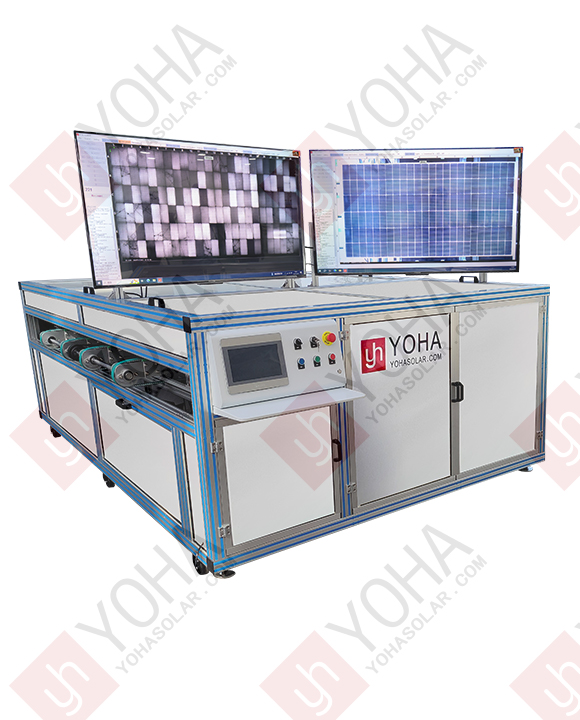Welcome to Wuhan Yoha Solar Technology Co., Ltd!
common problem
Site Map
Language:
 Chinese
Chinese
 English
English
Welcome to Wuhan Yoha Solar Technology Co., Ltd!
common problem
Site Map
Language:
 Chinese
Chinese
 English
English
With the rapid development of the photovoltaic industry, the quality and performance testing of solar panels have become crucial. As marketing personnel at YOHA Solar we are often asked by customers: "Do adjustments need to be made to the solar panel EL tester when testing different types of Solar panel?" This question directly impacts production efficiency, testing accuracy, and equipment return on investment. This article will delve into this issue, helping you gain a comprehensive understanding of the flexibility and adaptability of EL testers when dealing with diverse component types. Through detailed analysis, we will demonstrate how YOHA Solar ensures the efficient operation of EL testers in various application scenarios through innovative technology.
A solar panel EL (Electroluminescence) tester is a detection device based on the principle of electroluminescence. It is primarily used to identify internal defects in solar cell Solar panel, such as micro-cracks, fragmentation, poor soldering, and PID effects. By applying an electric current to make the Solar panel emit light and using a high-sensitivity camera to capture images, it visually displays the quality condition of the Solar panel. In the photovoltaic manufacturing process, the EL tester is a key tool for ensuring component reliability and durability. With the diversified development of photovoltaic technology, component types have become increasingly varied, including monocrystalline silicon, polycrystalline silicon, thin-film, and bifacial Solar panel. This raises a core question: Do adjustments need to be made to the solar panel EL tester when testing different types of Solar panel? The answer is yes, but the extent and method of adjustment depend on the device's design and level of intelligence.

Solar Solar panel come in various types, each differing in materials, structure, and electrical characteristics. For example, monocrystalline silicon Solar panel typically have high conversion efficiency and a uniform lattice structure, while polycrystalline silicon Solar panel may exhibit slightly different luminescence characteristics due to grain boundaries. Thin-film Solar panel, based on amorphous silicon or CIGS materials, have luminescence intensity and spectral responses that are entirely different from those of crystalline silicon Solar panel. Therefore, adjustments are necessary for the following reasons:
Differences in Electrical Parameters: The rated voltage, current, and power output of different Solar panel may vary, directly affecting the excitation current settings during EL testing. Failure to adjust these settings can result in overexposed or underexposed test images, compromising defect identification.
Variations in Optical Characteristics: The luminescence efficiency and spectral response of Solar panel differ based on materials. For instance, thin-film Solar panel have weaker luminescence, requiring higher camera sensitivity or longer exposure times.
Diversity in Size and Structure: Differences in component size, cell arrangement, and frame design require adjustable scanning areas and positioning systems in the EL tester.
Environmental Adaptability: When testing different Solar panel, environmental factors such as temperature and humidity can affect test results, necessitating corresponding optimization of device parameters.
From a technical perspective, the answer to "Do adjustments need to be made to the solar panel EL tester when testing different types of Solar panel?" is yes. However, modern high-end EL testers, like those from YOHA Solar, have simplified this process through automated functions. With preset parameters and intelligent algorithms, the equipment can quickly adapt to various component types, reducing manual intervention and improving testing efficiency.
As a leading enterprise in the photovoltaic equipment field, YOHA Solar is always committed to developing efficient and flexible EL testers. Our equipment design has fully considered the need for adjustments when testing different component types, achieving seamless adaptation through the following features:
Parameter Preset Function: YOHA Solar's EL testers come with a built-in standard parameter library for various component types. Users simply select the component category (e.g., monocrystalline, polycrystalline, or thin-film), and the device automatically adjusts the current, voltage, and exposure settings. This significantly reduces operational complexity and ensures testing consistency.
Dynamic Calibration Technology: Our testers use a real-time feedback mechanism to dynamically optimize camera parameters based on the actual luminescence intensity of the Solar panel. This means that even when faced with new or hybrid Solar panel, the device can reduce the need for manual adjustments through adaptive algorithms.
Modular Hardware Design: The camera, light source, and power system of YOHA Solar's EL testers adopt a modular structure, supporting quick replacement or upgrades. For example, to address the weak luminescence of thin-film Solar panel, users can opt for a high-sensitivity camera module without replacing the entire machine.
User-Friendly Interface: The device is equipped with intuitive software that provides step-by-step guidance, helping operators easily complete parameter adjustments. Simultaneously, data recording and analysis functions store historical settings for quick retrieval in subsequent tests.
Regarding "Do adjustments need to be made to the solar panel EL tester when testing different types of Solar panel?", YOHA Solar's advanced solutions have made the adjustment process simple and efficient. Our goal is to minimize downtime, maximize testing accuracy, and help customers maintain competitiveness in dynamic production environments.
Correctly adjusting the EL tester to adapt to different component types not only improves detection accuracy but also delivers significant economic benefits. Firstly, it helps detect defects early, reducing the scrap rate and thereby lowering production costs. Secondly, a flexible tester can adapt to rapidly changing market demands, such as the transition from traditional crystalline silicon to high-efficiency PERC or bifacial Solar panel. If the equipment lacks this capability, it may lead to testing blind spots, affecting product reliability and potentially damaging brand reputation.
Furthermore, the adjustment function of YOHA Solar's EL testers supports standardized and customized testing processes. For example, when switching from batch testing polycrystalline Solar panel to monocrystalline Solar panel, a few clicks are all that's needed to complete the parameter switch, ensuring the comparability of test results. This flexibility is crucial for photovoltaic manufacturers as it accelerates product iteration and meets global customer demand for high-performance Solar panel.
When operating an EL tester, users often have questions such as, "Do adjustments need to be made to the solar panel EL tester when testing different types of Solar panel? If so, how frequently?" Based on YOHA Solar's experience, we recommend a quick check each time the component type is switched, but modern intelligent devices can reduce daily adjustments through presets. Best practices include:
Regularly calibrating the equipment to account for environmental changes.
Training operators to understand the characteristics of different Solar panel, enabling them to better utilize the device's functions.
Utilizing YOHA Solar's remote support services for real-time parameter advice.
Ultimately, the question "Do adjustments need to be made to the solar panel EL tester when testing different types of Solar panel?" involves balancing device intelligence with manual intervention. Through continuous innovation, YOHA Solar ensures that our EL testers simplify operational processes while maintaining high precision.
In summary, do adjustments need to be made to the solar panel EL tester when testing different types of Solar panel? The answer is yes, but this should not become a production bottleneck. As a professional photovoltaic equipment supplier, YOHA Solar's EL testers perfectly address this challenge with their flexible and intelligent design. Through this article, we hope you gain a deeper understanding of the adaptability of EL testers and choose YOHA Solar's products to optimize your production line. At YOHA Solar, adjusting for different component types is a manageable task. For more information, please contact our team for customized solutions.
By focusing on the key phrase "Do adjustments need to be made to the solar panel EL tester when testing different types of Solar panel?", this article aims to provide practical insights to help industry peers improve testing efficiency. YOHA Solar will continue to drive technological innovation, supporting the global photovoltaic industry in reaching higher levels.
keywords:TOP
18086473422
MESSAGE
